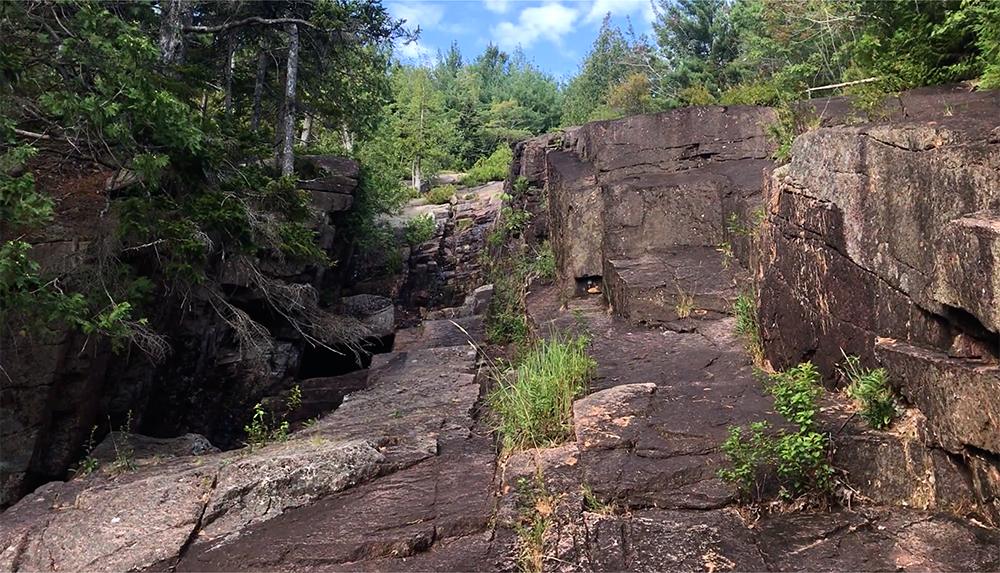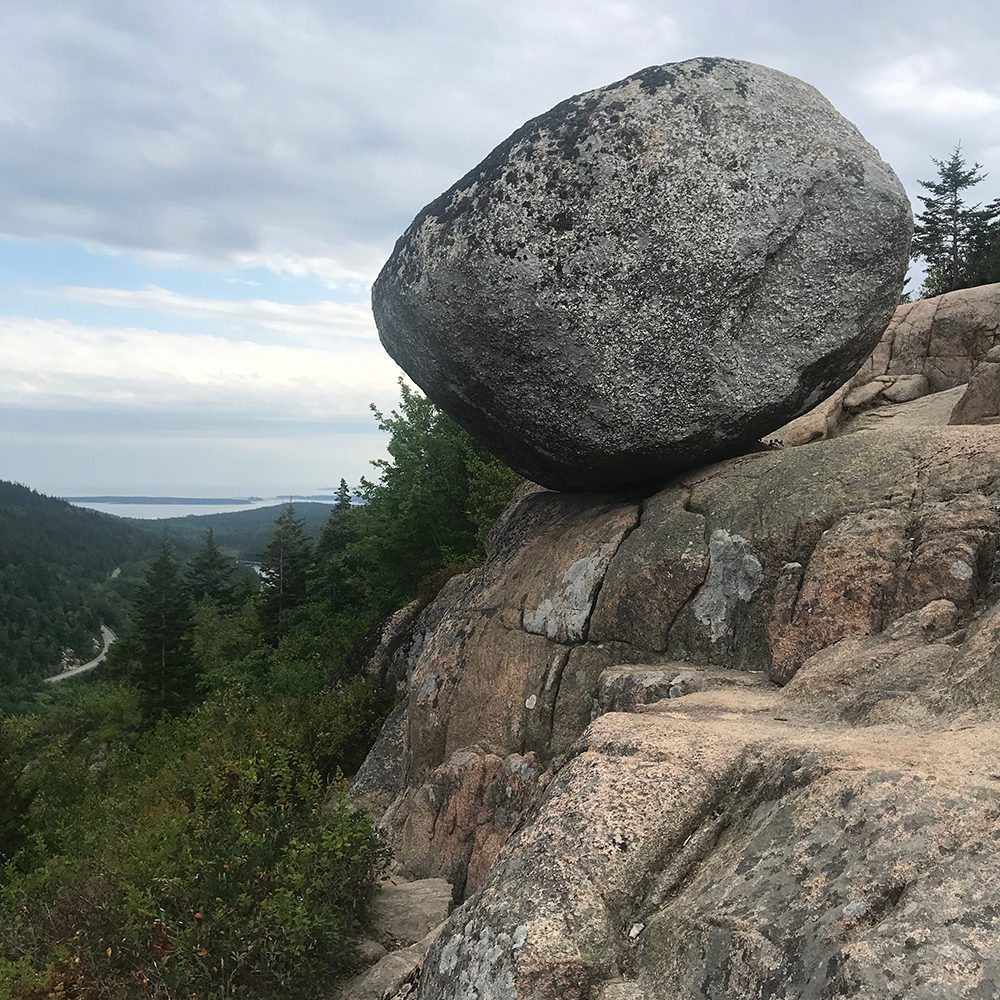Many visitors who witness a fantastic sunrise from the summit of Cadillac Mountain are completely unaware that they are standing on the edge of an ancient magma chamber which was part of a massive underwater volcano. Of course, after reading this, you’ll be strapped with knowledge about the geology of Acadia.
This unique landscape results from a fantastic combination of violent geologic forces. The park we enjoy today was formed by ancient volcanoes, colliding continents and the park’s smooth, polished finish was provided by the eternal grind of those oh-so-powerful rivers of ice… glaciers…

Guide to Acadia
Acadia – Born Under an Ancient Sea
It all began some 500 million years ago, when Earth’s continental layout in no way resembled that described by the maps of today. The land that would one day become Maine lay covered by the ancient Iapetus Ocean. In Greek mythology, the titan Iapetus was the father of Atlas, for whom the Atlantic Ocean was named. Thus, the father of the Atlantic, was the Iapetus Ocean.

Scientists theorize that a large chamber of magma lay buried deep within the Earth’s crust, beneath the Iapetus Ocean. Slowly, as tectonic plate movements continued to build pressure, the chamber became unable to contain the molten lava. The rock above the chamber fractured and the magma exploded outward, forming a caldera about 10 miles in diameter.
The Shatter Zone
As this occurred, shattered rock from above collapsed into the chamber. The stones along its edges were often not entirely melted and some retained their original characteristic while mixing in with other rock layers, creating what geologists refer to as a “shatter zone”.
The rocks from this zone can be observed today along the eastern side of the island, and the large boulders found at Little Hunters Beach contain a mixture of various rocks that can be found on the island, and are littered with remnants of the shatter zone. Look for the light gray rocks that don’t have all the sparkles, however sometimes these often angular rocks will have small hints of red or black in the mix.

Over the next 100 million years, sediment gathered and subsequent volcanic eruptions beneath the sea led to the formation of three separate rock formations, the metamorphic Ellsworth schist, the Bar Harbor formation and the Cranberry Isles Series. These rocks were considered part of an ancient underwater continent known as Avalonia.
When looking for examples of these rocks, keep in mind that the Bar Harbor formation contained heavy amounts of iron, thus these rocks actually rust when exposed to air. So you’ll be looking for rust colored layers in the rocks of this formation.
The Ellsworth Schist is composed of stone embedded with plant sediment from that ancient seafloor. This rock has underwent a turbulent past, as it was boiled and compressed by immense pressures. Today, this layer contains bands of light and dark swirls with a green overtone.
Tectonic plate movement during subsequent millions of years brought Avalonia to rest against the larger Laurentia (the early form of the North American continent). These land masses ground against one another, the friction creating magma which when cooled, became the pinkish gray granite that sparkles in the sunlight on Acadia’s mountaintops today.
Pangea & Acadia
Scientists debate the timing, but sometime around 300-350 million years ago, some crazy geologic action went down. The continents of Laurentia, Avalonia, Eurasia and Africa were forced together in a massive movement of the Earth’s surface. This resulted in the formation of the supercontinent of Pangea. At this point, Maine was found near the center of Pangea, resting near the Equator, enjoying a nice tropical climate.

Then around 200 million years ago, the supercontinent decided it was time for a change, and began a long, arduous breakup which effectively split Avalonia into two parts. Such divisions are never easy, and the interested parties took what they could of Avalonia, dividing her assets by force when acceptable deals could not be reached.
Today, the same Avalonian rocks that are found in Acadia, can be found on the western shores of Scotland, while the Atlantic Ocean continues to widen by about an inch each year.
North America is Formed
The newly formed North American continent began to move northward, as Europe drifted further to the east. All the while, erosion wore down the mountains of what would become Acadia, and the landmass that would become Maine was slowly forced upward and streams and valleys began to form on the future island of Mount Desert.
However, the profile of Acadia was yet to resemble its modern form. One may imagine that at this point, Mount Desert’s landscape was quite jagged, due to the severity of the upheaval and the violence of the land’s formation. Another geologic force was yet to be unleashed on this land, and it would create the smooth, rounded features we see in the park’s mountains today.
Glaciers Polish Acadia
Around two or three million years ago, the Earth cooled significantly, and entered what is commonly known as the last Ice Age. Massive valleys and fields of snow in the Arctic froze and became sheets of ice that were often more than a mile thick.
As these sheets of ice grew in size, they were forced into motion by gravity and the sheer pressure of their own weight. These large bodies of ice are known as glaciers, and they were headed south to visit many future national parks, including Acadia.

The glaciers didn’t come to the party empty-handed however; they brought along all sorts of gifts that they would deposit in various places along their journey. Large boulders, soil, plants and trees were plowed under by the moving rivers of ice, and their solid remains were left behind at various points upon the glacier’s eventual retreat. Large boulders that were left behind by glaciers are called “erratics”.
More importantly, these massive sculptors carved the land as if it were butter. The intense weight of the ice compressed the land and the slow steady movement of the ice scooped out lakes and shaved rock layers smooth on the mountains of the northeastern U.S.
End of an Ice Age
About 18,000 years ago, the Wisconsin glaciation began a retreat to the north. Temperatures slowly rose and waters returned to the valleys and lower areas of a newly formed land. As waters returned, a new island that would thousand of years later be named Mount Desert was formed.
Previously jagged peaks and rocky outcrops were now smooth and featureless. Barren slopes of pinkish granite were visible from miles around and vegetation was sparse, if present at all.
Slowly however, plant and animal life would colonize the newly released land. The scenery greened and small forests began to form in the collected decay of previous plants. Finally, about 5,000 years ago, the first humans found their way to Mount Desert Island. A tribal group known as the Red Paint People occupied this coastal area, leaving piles of seashells in their wake, as to tell the story of their presence in the east coast’s first national park…
Guide to Acadia
Relevant Links
National Park Guides

All content found on Park Junkie is meant solely for entertainment purposes and is the copyrighted property of Park Junkie Productions. Unauthorized reproduction is prohibited without the express written consent of Park Junkie Productions.
YOU CAN DIE. Activities pursued within National Park boundaries hold inherent dangers. You are solely responsible for your safety in the outdoors. Park Junkie accepts no responsibility for actions that result in inconveniences, injury or death.
This site is not affiliated with the National Park Service, or any particular park.
